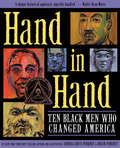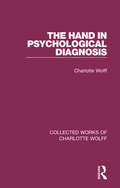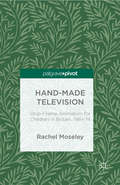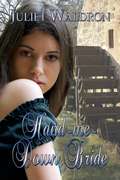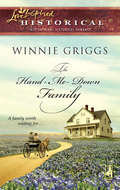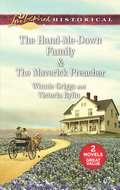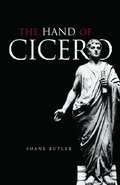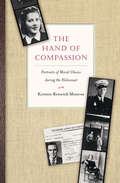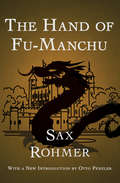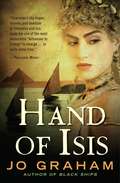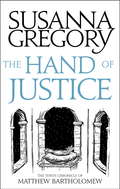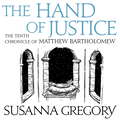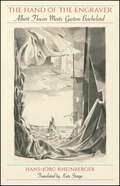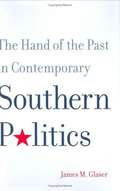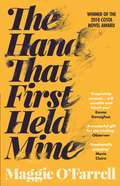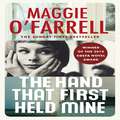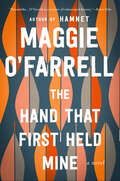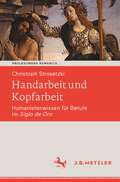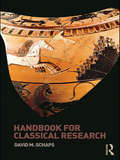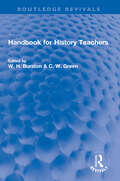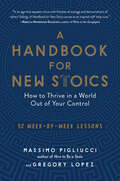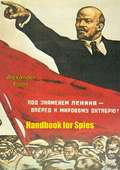- Table View
- List View
Hand in Hand: Ten Black Men Who Changed America
by Andrea PinkneyHand in Hand presents the stories of ten men from different eras in American history, organized chronologically to provide a scope from slavery to the modern day. The stories are accessible, fully-drawn narratives offering the subjects' childhood influences, the time and place in which they lived, their accomplishments and motivations, and the legacies they left for future generations as links in the "freedom chain." This book will be the definitive family volume on the subject, punctuated with dynamic full color portraits and spot illustrations by two-time Caldecott Honor winner and multiple Coretta Scott King Book Award recipient Brian Pinkney. Backmatter includes a civil rights timeline, sources, and further reading. Profiled: Benjamin Banneker Frederick Douglass Booker T. Washington W.E.B. DuBois A. Philip Randolph Thurgood Marshall Jackie Robinson Malcolm X Martin Luther King, Jr Barack H. Obama II
The Hand in Psychological Diagnosis (Collected Works of Charlotte Wolff #3)
by Charlotte WolffOriginally published in 1951, this title looks at the study of the hand in relation to psychological diagnosis. This was at the time a new branch of psychology and the author is keen to point out it must not be viewed as perfect or indeed complete. Practical experience and a deeper understanding of psycho-motor phenomena had altered some of the author’s theoretical views since the earlier titles. This book builds on and extends her previous research, including new research studies particularly on children who were at the time termed ‘mentally defective’. It was designed to contribute some new diagnostic possibilities to psychology and psychiatry. Today we can enjoy it as part of psychology’s history.
Hand-Made Television: Stop-Frame Animation for Children in Britain, 1961-1974
by R. MoseleyHand-Made Television explores the ongoing enchantment of many of the much-loved stop-frame children's television programmes of 1960s and 1970s Britain. The first academic work to analyse programmes such as Pogles' Wood (1966), Clangers (1969), Bagpuss (1974) (Smallfilms) and Gordon Murray's Camberwick Green (1966), Trumpton (1967) and Chigley (1969), the book connects these series to their social and historical contexts while providing in-depth analyses of their themes and hand-made aesthetics. Hand-Made Television shows that the appeal of these programmes is rooted not only in their participatory address and evocation of a pastoral English past, but also in the connection of their stop-frame aesthetics to the actions of childhood play. This book makes a significant contribution to both Animation Studies and Television Studies; combining scholarly rigour with an accessible style, it is suitable for scholars as well as fans of these iconic British children's programmes.
Hand Me Down Bride
by Juliet WaldronTo help her impoverished family, Sophie agrees to marry a wealthy older in far off America. Less than twenty-four hours after she arrives in German’s Mill, Pennsylvania, events have taken a far stranger turn than anything she could have imagined. Set in Post-Civil-War Pennsylvania, this tale of an arranged marriage is as much family saga as romance. Sophie is a sensitive young woman struggling to make sense of her past and to understand her new homeland. Karl is not only a veteran of the Great War, but scarred by the secret violence of his childhood. How they both learn to trust—and to love—is their unique story.
The Hand-Me-Down Family
by Winnie GriggsCallie Gray always assumed she would never marry, until she took a leap and became a mail-order bride. But when she arrives in Sweetgum, Texas, she gets the shock of her life. Her husband is dead, and his brother proposes she marry him, for the sake of his orphaned nephew and nieces. Jack Tyler warns her not to hope for a love match--theirs is strictly a convenient marriage. But Callie yearns for a true partnership with the man who has unexpectedly captured her heart. Now she must convince him what he truly needs is a lifetime of love, faith and family--with Callie by his side.
The Hand-Me-Down Family & The Maverick Preacher: An Anthology
by Winnie Griggs Victoria BylinAn unexpected familyThe Hand-Me-Down FamilyWhen mail-order bride Callie Gray arrives in Sweetgum, Texas, she gets the shock of her life. Her husband is dead, and his brother proposes she marry him, for the sake of his orphaned nephew and nieces. Jack Tyler warns her this is strictly a marriage of convenience. But Callie yearns for a true partnership. Now she must convince Jack what he needs is a lifetime of love, faith and family—with Callie.The Maverick PreacherOnce one of Boston’s most righteous ministers, now Joshua Blue is a guilt-stricken man scouring the West to find the sister he drove away. The trail leads him to Denver, where beautiful boardinghouse owner Adelaide Clark and her young son might hold the key to unlocking past secrets. Adie fears Josh’s presence could tear her family apart. But his strong faith sparks Adie’s long-buried hope for a future with a God-sent partner…
The Hand of Cicero
by Shane ButlerHundreds perished in Rome's Second Proscription, but one victim is remembered above all others. Cicero stands out, however, not only because of his fame, but also because his murder included a unique addition to the customary decapitation. For his corpse was deprived not only of its head, but also of its right hand. Plutarch tells us why Mark Antony wanted the hand that wrote the Philippics. But how did it come to pass that Rome's greatest orator could be so hated for the speeches he had written?Charting a course through Cicero's celebrated career, Shane Butler examines two principal relationships between speech and writing in Roman oratory: the use of documentary evidence by orators and the 'publication' of both delivered and undelivered speeches. He presents this fascinating theory that the success of Rome's greatest orator depended as much on writing as speaking; he also argues against the conventional wisdom that Rome was an 'oral society', in which writing was rare and served only practical, secondary purposes.
The Hand of Compassion: Portraits of Moral Choice during the Holocaust
by Kristen Renwick MonroeThrough moving interviews with five ordinary people who rescued Jews during the Holocaust, Kristen Monroe casts new light on a question at the heart of ethics: Why do people risk their lives for strangers and what drives such moral choice? Monroe's analysis points not to traditional explanations--such as religion or reason--but to identity. The rescuers' perceptions of themselves in relation to others made their extraordinary acts spontaneous and left the rescuers no choice but to act. To turn away Jews was, for them, literally unimaginable. In the words of one German Czech rescuer, "The hand of compassion was faster than the calculus of reason." At the heart of this unusual book are interviews with the rescuers, complex human beings from all parts of the Third Reich and all walks of life: Margot, a wealthy German who saved Jews while in exile in Holland; Otto, a German living in Prague who saved more than 100 Jews and provides surprising information about the plot to kill Hitler; John, a Dutchman on the Gestapo's "Most Wanted List"; Irene, a Polish student who hid eighteen Jews in the home of the German major for whom she was keeping house; and Knud, a Danish wartime policeman who took part in the extraordinary rescue of 85 percent of his country's Jews. We listen as the rescuers themselves tell the stories of their lives and their efforts to save Jews. Monroe's analysis of these stories draws on philosophy, ethics, and political psychology to suggest why and how identity constrains our choices, both cognitively and ethically. Her work offers a powerful counterpoint to conventional arguments about rational choice and a valuable addition to the literature on ethics and moral psychology. It is a dramatic illumination of the power of identity to shape our most basic political acts, including our treatment of others. But always Monroe returns us to the rescuers, to their strong voices, reminding us that the Holocaust need not have happened and revealing the minds of the ethically exemplary as they negotiated the moral quicksand that was the Holocaust.
The Hand of Fu-Manchu
by Otto Penzler Sax RohmerFrom beyond the grave, Fu-Manchu reaches out to destroy the worldWhen Dr. Petrie saw a bullet enter the skull of the fiendish mastermind Fu-Manchu, he assumed England had nothing more to fear from the evil genius. But Nayland Smith knows that whatever became of the devil doctor, the sinister organization he served will go on trying to conquer the world.Sir Gregory Hale, erstwhile attaché to the British Embassy in Peking, might be the key to foiling the Si-Fan. Just back from a six-month expedition to the Gobi Desert, Hale is holed up in a London hotel and refuses to see anyone but Smith. Ten minutes before the Burmese commissioner reaches him, Hale is struck dumb by a deadly poison. In his final seconds, he manages to scratch out a warning: “Guard my diary. . . . Tibetan frontier . . . Key of India. Beware man . . . with the limp.”Those last words, and the brass box Hale brought back with him from Mongolia, are the only ammunition Smith and Petrie have in their fight against an army more powerful than any the world has ever known.This ebook features a new introduction by Otto Penzler and has been professionally proofread to ensure accuracy and readability on all devices.
Hand of Isis
by Jo GrahamOnce, in a palace by the sea, there were three sisters born in the same year. The eldest was born in the season of planting, when the waters of the Nile had receded once more and the land lay rich and fertile, warm and muddy and waiting for the sun to quicken everything to life. She was born in one of the small rooms behind the Court of Birds, and her mother was a serving woman who cooked and cleaned, but who one day had caught Ptolemy Auletes' eye. Her skin was honey, her eyes dark as the rich floodwaters. Her name was Iras. The second sister was born under the clear stars of winter, while the land greened and grain ripened in the fields, when fig and peach trees nodded laden in the starry night. She was born in a great bedchamber with wide windows open to the sea, and five Greek physicians in attendance, for she was the daughter of Ptolemy Auletes' queen, and her name was Cleopatra. The youngest sister was born as the earth died, as the stubble of the harvest withered in the fields beneath the scorching sun. She was born beside the fountain in the Court of Birds, because her mother was a blond slave girl from Thrace, and that was where her pains took her. Water fell from the sky and misted her upturned face. Her hair was the color of tarnished bronze, and her eyes were blue as the endless Egyptian sky. Her name was Charmian. Once, in a palace by the sea, there were three sisters. All the stories begin so.
The Hand Of Justice: The Tenth Chronicle of Matthew Bartholomew (Chronicle Of Matthew Bartholomew #10)
by Susanna GregoryIn February 1355, amid the worst snows in living memory, two well-born murderers return to Cambridge after receiving the King's pardon - but they show no remorse, and are in fact ready to confront those who helped convict them. When Matthew Bartholomew is called to the local mill to examine two corpses, he and Brother Michael know who to question, but in the fledgling university city, nothing is ever as straightforward as it seems...
The Hand Of Justice: The Tenth Chronicle of Matthew Bartholomew (Chronicles of Matthew Bartholomew #10)
by Susanna GregoryFor the twentieth anniversary of the start of the Matthew Bartholomew series, Sphere is delighted to reissue all of the medieval monk's cases with beautiful new series-style covers.------------------------------------The winter of 1353 has been appallingly wet, there is a fever outbreak amongst the poorer townspeople and the country is not yet fully recovered from the aftermath of the plague. The increasing reputation and wealth of the Cambridge colleges are causing dangerous tensions between the town, Church and University. Matthew Bartholomew is called to look into the deaths of three members of the University of who died from drinking poisoned wine, and soon he stumbles upon criminal activities that implicate his relatives, friends and colleagues - so he must solve the case before matters in the town get out of hand...In February 1355, amid the worst snows in living memory, two well-born murderers return to Cambridge after receiving the King's pardon - but they show no remorse, and are in fact ready to confront those who helped convict them. When Matthew Bartholomew is called to the local mill to examine two corpses, he and Brother Michael know who to question, but in the fledgling university city, nothing is ever as straightforward as it seems...
The Hand Of Justice: The Tenth Chronicle of Matthew Bartholomew (Chronicles of Matthew Bartholomew #10)
by Susanna GregoryIn Cambridge 1355 the colleges of the fledgling university are as much at odds with each other as they are with the ordinary townfolk. This tension has recently been heightened by the return of two well-born murderers after receiving the King's pardon, showing no remorse but ready to confront those who helped convict them. And in the midst of this Bartholomew the physician is called to the local mill to examine two corpses. It is almost a relief to be able to turn his back on the fractious town, but as always in Cambridge nothing is disconnected.
The Hand of the Engraver: Albert Flocon Meets Gaston Bachelard (SUNY series, Intersections: Philosophy and Critical Theory)
by Hans-Jörg RheinbergerThis book is the first to explore in detail the encounter between Albert Flocon and Gaston Bachelard in postwar Paris. Bachelard was a philosopher and historian of science who was also involved in literary studies and poetics. Flocon was a student of the Bauhaus in Dessau, Germany, who specialized in copper engraving. Both deeply ingrained in the surrealist avant-garde movements, each acted at the frontiers of their respective métiers in exploring uncharted territory. Bachelard experienced the sciences of his time as constantly undergoing radical changes, and he wanted to create a historical epistemology that would live up to this experience. He saw the elementary gesture of the copper engraver—the hand of the engraver—as meeting the challenge of resistant and resilient matter in an exemplary fashion. Flocon was fascinated by Bachelard's unconventional approach to the sciences and his poetics. Together, their relationship interrogated and celebrated the interplay of hand and matter as it occurs in poetic writing, in the art of engraving, and in scientific experimentation. In the form of a double biography, Hans-Jörg Rheinberger succeeds in writing a lucid intellectual history and at the same time presents a fascinating illustrated reading of Flocon's copper engravings.
The Hand of the Past in Contemporary Southern Politics
by James M. GlaserA central story of contemporary southern politics is the emergence of Republican majorities in the region's congressional delegation. Acknowledging the significance and scope of the political change, James M. Glaser argues that, nevertheless, strands of continuity affect the practice of campaign politics in important ways. Strong southern tradition underlies the strategies pursued by the candidates, their presentational styles, and the psychology of their campaigns. The author offers eyewitness accounts of recent congressional campaigns in Texas, Mississippi, Virginia, North Carolina, and South Carolina. In the tradition of his award-winning book Race, Campaign Politics, and the Realignment in the South,Glaser captures the "stuff" of politics--the characters, the images, the rhetoric, and the scenery. Painting a full and fascinating picture of what it is like on the campaign trail, Glaser provides wide-ranging insights into the ways that the "hand of the past" reaches into the southern present.
The Hand That First Held Mine
by Maggie O'FarrellWinner of the 2010 Costa Novel Award and a Sunday Times bestseller, THE HAND THAT FIRST HELD MINE by Maggie O'Farrell is a gorgeously written story of love and motherhood from the author of HAMNET and I AM, I AM, I AM.When the sophisticated Innes Kent turns up on her doorstep, Lexie Sinclair realises she cannot wait any longer for her life to begin, and leaves for London. There, at the heart of the 1950s Soho art scene, she carves out a new life. In the present day, Elina and Ted are reeling from the difficult birth of their first child. Elina struggles to reconcile the demands of motherhood with her sense of herself as an artist, and Ted is disturbed by memories of his own childhood that don't tally with his parents' version of events. As Ted begins to search for answers, an extraordinary portrait of two women is revealed, separated by fifty years, but connected in ways that neither could ever have expected.
The Hand That First Held Mine
by Maggie O'FarrellWinner of the 2010 Costa Novel Award and a Sunday Times bestseller, THE HAND THAT FIRST HELD MINE by Maggie O'Farrell is a gorgeously written story of love and motherhood from the author of HAMNET and I AM, I AM, I AM.When the sophisticated Innes Kent turns up on her doorstep, Lexie Sinclair realises she cannot wait any longer for her life to begin, and leaves for London. There, at the heart of the 1950s Soho art scene, she carves out a new life. In the present day, Elina and Ted are reeling from the difficult birth of their first child. Elina struggles to reconcile the demands of motherhood with her sense of herself as an artist, and Ted is disturbed by memories of his own childhood that don't tally with his parents' version of events. As Ted begins to search for answers, an extraordinary portrait of two women is revealed, separated by fifty years, but connected in ways that neither could ever have expected.
The Hand That First Held Mine
by Maggie O'FarrellWinner of the 2010 Costa Novel Award, THE HAND THAT FIRST HELD MINE is a gorgeously written story of love and motherhood, a tour de force from one of our best loved novelists.When the bohemian, sophisticated Innes Kent turns up by chance on her doorstep, Lexie Sinclair realises she cannot wait any longer for her life to begin, and leaves for London. There, at the heart of the 1950s Soho art scene, she carves out a new life for herself, with Innes at her side. In the present day, Elina and Ted are reeling from the difficult birth of their first child. Elina, a painter, struggles to reconcile the demands of motherhood with sense of herself as an artist, and Ted is disturbed by memories of his own childhood, memories that don't tally with his parents' version of events. As Ted begins to search for answers, so an extraordinary portrait of two women is revealed, separated by fifty years, but connected in ways that neither could ever have expected.(P)2010 Headline Digital
The Hand That First Held Mine: A Novel
by Maggie O'FarrellLexie Sinclair is plotting an extraordinary life for herself.Hedged in by her parents' genteel country life, she plans her escape to London. There, she takes up with Innes Kent, a magazine editor who wears duck-egg blue ties and introduces her to the thrilling, underground world of bohemian, post-war Soho. She learns to be a reporter, to know art and artists, to embrace her life fully and with a deep love at the center of it. She creates many lives--all of them unconventional. And when she finds herself pregnant, she doesn't hesitate to have the baby on her own.Later, in present-day London, a young painter named Elina dizzily navigates the first weeks of motherhood. She doesn't recognize herself: she finds herself walking outside with no shoes; she goes to the restaurant for lunch at nine in the morning; she can't recall the small matter of giving birth. But for her boyfriend, Ted, fatherhood is calling up lost memories, with images he cannot place.As Ted's memories become more disconcerting and more frequent, it seems that something might connect these two stories-- these two women-- something that becomes all the more heartbreaking and beautiful as they all hurtle toward its revelation.Here Maggie O'Farrell brings us a spellbinding novel of two women connected across fifty years by art, love, betrayals, secrets, and motherhood. Like her acclaimed The Vanishing Act of Esme Lennox, it is a "breathtaking, heart-breaking creation."*And it is a gorgeous inquiry into the ways we make and unmake our lives, who we know ourselves to be, and how even our most accidental legacies connect us.*The Washington Post Book World
Handarbeit und Kopfarbeit: Humanistenwissen für Berufe im Siglo de Oro (Prolegomena Romanica. Beiträge zu den romanischen Kulturen und Literaturen)
by Christoph StrosetzkiIn der frühen Neuzeit beschäftigen sich zahlreiche Texte mit Berufen, indem sie das jeweils erforderliche Wissen, einzelne Aufgabenfelder, Zweck, Ursprung und Prestige darstellen. Humanistisch ist der Argumentationsgang, insofern er meist vom Menschen ausgeht. Prägend ist dabei die antike Vorstellung vom Vorrang der Kopfarbeit vor der Handarbeit. Die Bedeutung Spaniens ergibt sich daraus, dass der spanische König Karl V. zugleich Kaiser und Herrscher über die Kolonien in Amerika war, also nach damaligen Verhältnissen ein Weltreich regierte. Nach der Erörterung einiger zentraler Kategorien werden Gesamtdarstellungen des Wissens, der Berufe und der herausragenden Berufsvertreter vorgestellt. Dabei ist die Hierarchisierung und deren Relativierung durch die Satire aufschlussreich. Anhand einzelner als charakteristische Beispiele ausgewählter Berufe mit jeweiligem spezifischen Wissen werden dann die mechanischen Künste und die artes liberales vorgeführt. Den Abschluss bilden die höheren Fakultäten Medizin, Theologie und Jurisprudenz mit ihren Vertretern.
Handbook For CGS 2019
by Muthuswamy BrindaTo sustain its usefulness and popularity, we attach special importance to the annual production of the Handbook. We have on our editorial board members well versed in the rules and regulations in the concerned branches, experts in drafting, interpretation and editing of orders and instructions. They ensure that the language of the Handbook is lucid and free from the official jargon. As our address is included in the mailing list of the Ministry of Finance, of Home, etc., for circulation of their orders and O.M., we have instant access to the latest orders which enable us in no small measure to update our Handbook.
Handbook for Classical Research
by David M. SchapsOne of the glories of the Greco-Roman classics is the opportunity that they give us to consider a great culture in its entirety; but our ability to do that depends on our ability to work comfortably with very varied fields of scholarship. The Handbook for Classical Research offers guidance to students needing to learn more about the different fields and subfields of classical research, and its methods and resources. The book is divided into 7 parts: The Basics, Language, The Traditional Fields, The Physical Remains, The Written Word, The Classics and Related Disciplines, The Classics since Antiquity. Topics covered range from history and literature, lexicography and linguistics, epigraphy and palaeography, to archaeology and numismatics, and the study and reception of the classics. Guidance is given not only to read, for example, an archaeological or papyrological report, but also on how to find such sources when they are relevant to research. Concentrating on "how-to" topics, the Handbook for Classical Research is a much needed resource for both teachers and students.
Handbook for History Teachers (Routledge Revivals)
by W. H. Burston C. W. GreenFirst published in 1972, Handbook for History Teachers is intended to be a general and comprehensive work of reference for teachers of history in primary and secondary schools of all kinds. The book covers all aspects of teaching history: among them are the use of sources, world history, art and history; principles of constructing a syllabus and the psychological aspects of history teaching. The bibliographical sections are arranged on three parts: school textbooks, a section on audio-visual-aids and, finally, books for the teacher and possibly for the sixth form. It thoroughly investigates and critiques the various methods employed in teaching history within classrooms and suggests alternatives wherever applicable. Diligently curated by the Standing Sub-Committee in History, University of London Institute of Education, the book still holds immense value in the understanding of pedagogy.
A Handbook for New Stoics: How To Thrive In A World Out Of Your Control--52 Week-by-week Lessons
by Gregory Lopez Massimo PigliucciA pragmatic philosophy more popular than ever—here are 52 ancient lessons to help you overcome adversity and find tranquility in the modern world Stress often comes from situations that are beyond our control—such as preparing for a meeting, waiting for test results, or arguing with a loved one. But we can control our response to these everyday tensions—through the wisdom and practice of Stoicism. Stoicism is an ancient pragmatic philosophy that teaches us to step back, gain perspective, and act with intention. In A Handbook for New Stoics, renowned philosopher Massimo Pigliucci and seasoned practitioner Gregory Lopez provide 52 week-by-week lessons to help us apply timeless Stoic teachings to modern life. Whether you’re already familiar with Seneca and Marcus Aurelius, or you’re entirely new to Stoicism, this handbook will help you embrace challenges, thrive under pressure, and discover the good life!
Handbook for Spies
by Alexander FooteSeeking adventure, British citizen Alexander Foote fought the Fascists in the Spanish Civil War. Returning home after it ended, discouraged by the result, Foote was recruited into a Soviet network of spies against Nazi Germany. Based in Switzerland, Foote eventually became responsible for maintaining the network and forwarding information to the Centre in Russia. Foote describes for us how the network operated, including codes and secret transmissions, hiding from Swiss and German authorities, recruiting and funding, and eluding double agents. All the while, Foote watches Soviet Russia, presumably an ally to the free nations, become more and more like the Fascists Foote opposes. Eventually captured by Swiss police, Foote is debriefed in Russia, but manages to escape home to Britain after persuading the Soviets to send him on another mission. This is a fascinating story that illuminates a key part of the secret espionage networks undertaken during World War II.
